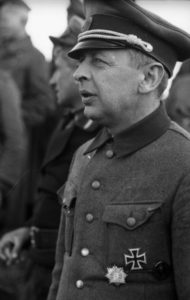
Matthew Raphael Johnson’s new podcast is an analysis of Lokot’, the part of Bryansk serving as the center of a socialist and nationalist social experiment under German-occupied Russia from 1941 to 1943. Most writers say it lasted until 1944 because the military leader, Brig. Gen. Bronislav Kaminski created the short-lived “Lepel Republic” in 1944 soon after its destruction. It is often taken as one and the same movement. Located just south of Bryansk city, southwest of Moscow and southeast of Smolensk, the “Lokot Autonomous Region” is the size of Belgium. It is a forested area that today includes parts of Kursk and Oryol oblasts. It is protected, lush and fertile.
Two weeks before the German invasion, the citizens there threw out the Reds and began designing their own society. At its height in 1943, it had an army of 12,000 (out of a population of 500,000), 9 hospitals, 345 schools, low taxes, state controlled currency, and an average peasant holding of 24 acres.
Land was free for all who could till it and industry was under state control. Much of this development was from the youth who spontaneously organized this after their suffering under the deadening life of Stalinist uniformity. The National Socialist Labor Party of Russia was headed by Konstantin Voskobojnik (killed in 1942) and its military was that of the Russian People’s Liberation Army (Russkaya Osvoboditelnaya Narodnaya Armiya) under Kaminski (killed just after the Warsaw uprising).
In the Manifesto of the Party it says: “Our party is the national movement. It remembers and honors the best traditions of the Russian people. She knows that the Vikings, our knighthood, helped create the foundation of the old Russian state. Our country has been destroyed and devastated by the Bolshevik government. This [present] senseless and shameful war, caused by the Bolsheviks, has destroyed thousands of cities and has harmed the productive capacity of our nation. . . . [we] send greetings to the courageous German nation, the destroyer of Stalinist serfdom.”
Of course, its history has been butchered by both Allied and Soviet historians and it remains a taboo subject. It is ripe for revisionism due to its success. However, the necessary information is only in Russian at present. Kaminski himself was ethnically half German and half Polish, but identified clearly as Russo-Ukrainian and saw his mission to destroy Stalinism.